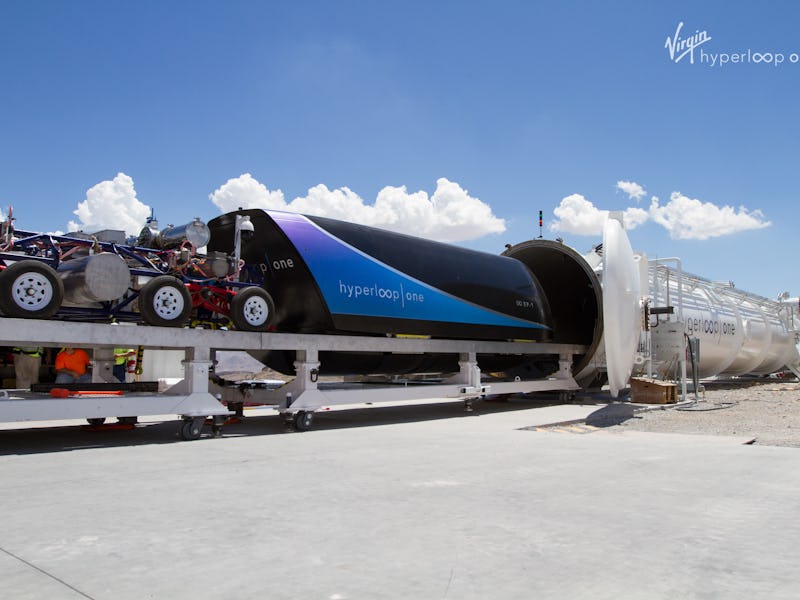Virgin Hyperloop One Will Debut an App for Suggesting Hyperloop Routes
Mexico City to Cabo. What would this look like?

For Virgin Hyperloop One, the goal is as simple as it is daunting: Have five hyperloop systems under construction by 2021. Beyond the considerable technical and logistical challenges that lie ahead, there’s another question: Just how is hyperloop going to fit into people’s larger travel plans?
It’s one the team hopes to answer with the announcement Monday at CES 2018, and it starts with an app. Made in collaboration with HERE Technologies, which provides mapping data to about 80 percent of the world’s automotive manufacturers, the navigation app is the first step for the Los Angeles-based startup.
Virgin Hyperloop One tells Inverse the app attempts to speak both to the present and future of users’ transportation needs. For now, it introduces features like step-by-step indoor directions that aren’t available in any other navigation app. It also offers users an opportunity to imagine and play around with potential hyperloop routes that would link together cities.
“We’ll give them the ability to use it on their day-to-day journey,” Matt Jones, the senior vice president for software engineering, tells Inverse. “It’s real data; it’s real public transit; real data from today. They will be able to request a Lyft, they will be able to work out where the nearest bike-share is in certain cities. But they also will be able to see overlays of potential hyperloop routes.”
There’s no set date for when the app will be released beyond sometime this year. Here’s a video Virgin Hyperlop One released of the new app though.
It offers a dreamy scenario of making the trip from LA to Vegas in a half-hour:
Suggest a New Hyperloop Route
“This is the first time I’ve said it, but realistically, I am absolutely going to ensure that through that app, people can suggest hyperloop routes,” Jones says. “Because they’re the people we serve. It’s not just about governments and nation-states. And to be honest, it’s obvious — or it is for me — that I want you, as a potential future user, to be able to say, ‘what it would be like if I connected, I don’t know, Mexico City with Cabo. What would this look like?’ And then hopefully we can get this ecosystem of players to look at what this would take and experiment with it.”
The overriding idea for the app is what Virgin Hyperloop One spokesperson Ryan Kelly describes as building an ecosystem around the speed demon that is a hyperloop pod. Since very few people are actually going to live and work inside hyperloop portals, they won’t actually have reached their final destination when the hyperloop journey is complete.
A comparison of real-world and hyperloop options in the app.
For Virgin Hyperloop One to be a full-service transit solution, it needs to integrate with public transportation and private ride-share options like Uber and Lyft. This app is the foundation for that eventual architecture.
Say it’s 2028. You wake up in Los Angeles and decide you absolutely must have lunch in your favorite restaurant in San Francisco. The future version of this app puts everything together, so users can seamlessly move from their door to a Lyft — by the 2020s, quite possibly a self-driving Lyft — to the nearest hyperloop portal, take it to San Francisco, then get directions down to the nearest foot of where in the Mission District that they want to go.
That’s 10 years from now, by which time Virgin Hyperloop One hopes to have successfully commercialized the technology that for now exists just on the Nevada test track.
But even now the app already promises to go further than competitors, offering directions in locations that Google Maps or Waze don’t yet have the ability to do so. That, according to Kelly, is what sets the HERE tech apart, and why this could be an intriguing option for users even if the hyperloop’s future isn’t their top priority.
“They’re really big on indoor walking directions, and that’s how far we’re going to make this the seamless travel experience of the future,” he tells Inverse. “So you’re in the Dubai Mall somewhere, you know you have to go down a flight of stairs to your right, around the left corner past the Starbucks, and your Uber is already going to be waiting for you by the time you get there. And that’s not something that any application is doing now, and as we move toward commercialization and getting operational by 2021, we have to take all these things into account.”
CES 2018 offers the latest benchmark for the Virgin Hyperloop One team on that path toward turning theoretical technology into practical reality. Appropriately for an event held in the first dozen days of the new year, CES offers the opportunity to lay down the kinds of practical goals that Kelly says will define the company’s work in 2018. The app is just the start.
“We never want to be seen as vaporware, we’ve proven that we’re not vaporware — 2017 was all about building the first and only full-scale hyperloop system,” he says. “You can expect this year for us to delve into more topics as we go into commercialization and start the process of getting this thing built. Things like security, energy, etc., more detailed things that we need to do to make this dream a reality.